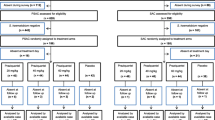Summary
In a randomized double-blind study, the percentage egg reduction and cure rate after the standard schedule of metrifonate treatment ofSchistosoma haematobium (3 doses of 7.5 mg·kg−1 at two-weekly intervals; A) and an abbreviated regimen (3 doses of 5 mg·kg−1 in one day; B) were compared in five villages in Somalia.
300 patients who were excreting 20 or more eggs ofS. haematobium in 10 ml urine were recruited. The patients were classified according to their home villages and were then, randomly allocated to treatment A or B. They had similar ages, weights and egg output. Each patient received 3 doses of metrifonate and 2 doses of identical appearing placebo. Group A received metrifonate on the 1st, 4th and 5th dosing occasions and placebo on the 2nd and 3rd times. Group B received metrifonate on the 1st, 2nd and 3rd dosing times and placebo on the 4th and 5th times.
Two hundred and one patients were followed up from 1 to 6 months. The remaining 99 (33%) patients either did not complete treatment or were lost during follow up. Egg reduction in the groups 1, 2, 3 and 6 months after treatment were 97, 97, 95 and 93% in Group A and 96, 96, 94 and 92% in Group B (NS). Corresponding cure rates for Group A were 52, 50, 48 and 44%, and in Group B they were 47, 48, 43 and 40% (NS). Seven patients from Group A and 9 from Group B complained of minor side-effects.
Thus, under field conditions abbreviated regimen of metrifonate 5 mg·kg−1 3-times in one day could have as much efficacy and safety as the standard schedule of 3 doses of 7.5 mg·kg−1 at two-weekly intervals.
Similar content being viewed by others
References
Lorenz W, Henglein A, Schrader G (1955) The new insecticide 0.0-dimethyl-2,2,2-trichloro-1-hydroxyethyl phosphonate. J Am Chem Soc 77: 2554
Lebrun A, Cerf C (1960) Note preliminaire sur la toxicite pour l'homme d'un insecticide organophosphorus (Diptrex). Bull WHO 22: 579–582
Cerf J, Lebrun A, Dierichx J (1962) A new approach to helminthiasis control: The use of an organophosphorus compound. Am J Trop Med Hyg 11: 514–517
Hanna S, Rasmy K, Selim O, Shoeb M, Awny AY (1966) Effect of administration of an organphosphorus compound as an antibilharzial agent, with reference to plasma cholinesterase. Br Med J 1: 1390–1392
Awadzi K, Orme MLE, Breckenridge AM, Haddock D, Gilles HM (1981) Studies of metrifonate on onchocerciasis. Acta Pharmacol Toxicol 49 [Suppl V]: 131–136
World Health Organization (1985) The control of schistosomiasis. Tech Rep Ser 728. WHO, Geneva
Aden Abdi Y, Gustafsson LL (1989) Poor patient compliance reduces the efficacy of metrifonate treatment ofSchistosoma haematobium in Somalia. Eur J Clin Pharmacol 36: 161–164
Plestina R, Davis A, Bailey DR (1972) Effect of metrifonate on blood cholinesterases in children during treatment of schistosomiasis. Bull WHO 46: 747–759
Snellen WM (1981) Therapeutic properties of metrifonate. Acta Pharmacol Toxicol 49 [Suppl V]: 114–117
Tswana SA, Mason PR (1985) Eighteen-month follow-up on the treatment of urinary schistosomiasis with a single dose of metrifonate. Am J Trop Med Hyg 34: 746–749
Arap Siongok TK, Ouman JH, Houser BH, Warren KSD (1978) Quantification of infection with schistosoma haematobium in relation to epidemiology and selective population chemotherapy. Mass treatment with a single dose of metrifonate. J Infect Dis 138: 856–858
Pugh RN, Teesdale CH (1983) Single dose oral treatment in urinary schistosomiasis, a double blind trial. Br Med J 286: 429–432
Aden Abdi Y, Gustafsson LL, Elmi SA (1987) A simplified dose schedule of metrifonate in the treatment ofSchistosoma haematobium infection in Somalia. Eur J Clin Pharmacol 32: 437–441
World Health Organization (1984) Epidemiological surveillance of communicable diseases in Somali Democratic Republic. National Morbidity Survey 1980/82. EM/EPID/78, EM/CD/31. WHO, Geneva
Koura M, Uptham S, Awad AH, Ahmed MD (1981) Prevalence of schistosoma haematobium in the Koryoole and Merca districts of the Somali Democratic Republic. Ann Trop Med Parasitol 75: 53–61
Peters PA, Warren KS, Mohamoud AAF (1976) Rapid, accurate quantification of schistosoma eggs via nucleopore filters. J Parasitol 62: 154–155
Daniel WW (1978) Applied nonparametric statistics. Houghton Mifflin, Boston
Kirkwood BR (1988) Essentials of medical statistics. Blackwell Scientific Publications, Oxford
Davis A (1968) Comparative trials of antimonial drugs in urinary Schistosomiasis. Bull WHO 38: 197–227
Davis A, Bailly DR (1969) Metrifonate in urinary schistosomiasis. Bull WHO 41: 209–224
Author information
Authors and Affiliations
Rights and permissions
About this article
Cite this article
Aden Abdi, Y., Gustafsson, L.L. Field trial of the efficacy of a simplified and standard metrifonate treatments ofSchistosoma haematobium . Eur J Clin Pharmacol 37, 371–374 (1989). https://doi.org/10.1007/BF00558502
Received:
Accepted:
Issue Date:
DOI: https://doi.org/10.1007/BF00558502




